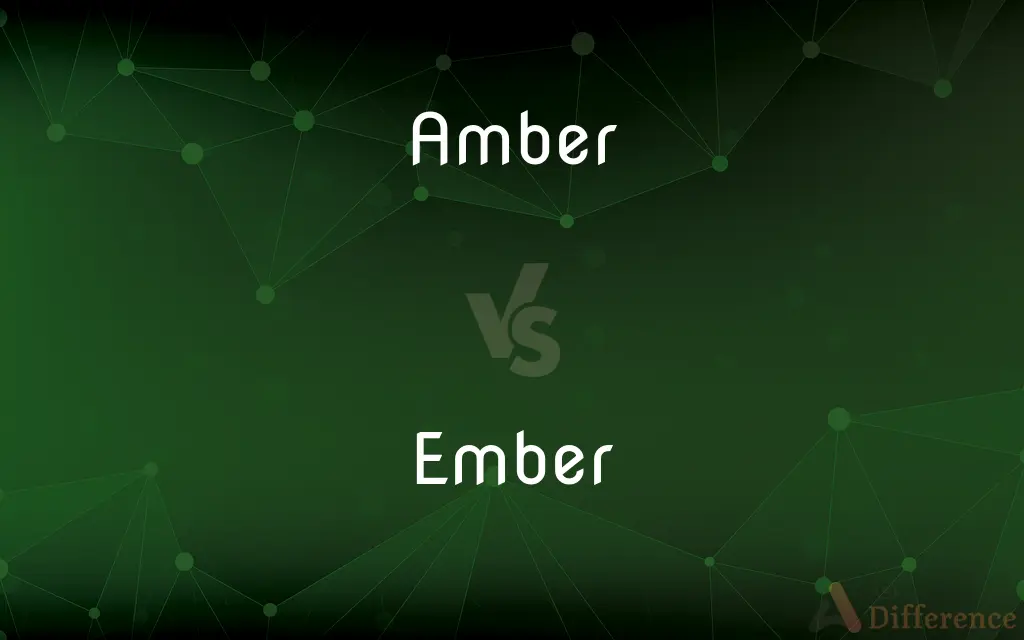Amber vs. Ember — What's the Difference?
By Maham Liaqat & Urooj Arif — Updated on March 25, 2024
Amber is fossilized tree resin, often used in jewelry, while ember refers to a glowing, hot coal left from a fire.

Difference Between Amber and Ember
Table of Contents
ADVERTISEMENT
Key Differences
Amber, known for its warm, golden hues, is fossilized tree resin that has been appreciated for centuries in jewelry and decoration. This organic gemstone can encapsulate ancient materials like insects, providing a window into the past. On the other hand, an ember is a glowing, hot coal made of wood or coal that remains after a fire has diminished. Embers can retain heat for a long time, glowing in the dark and capable of reigniting a flame.
The formation of amber is a process that spans millions of years, involving the hardening of tree resin under high pressure and over geological timescales. This natural process captures and preserves organic materials, making amber a fascinating subject for scientific study and a prized material for artisans. In contrast, embers are formed through the combustion of wood or coal, a much quicker process that results from the dying phase of a fire. Embers are known for their warmth and the potential to start a new fire, symbolizing endurance and the continuation of life.
Amber's use in jewelry and decorative items is primarily due to its beauty and the rarity of pieces containing prehistoric inclusions like insects or plant matter. Its warm colors range from yellow to orange and even green or blue, making it highly sought after for ornamental purposes. Embers, while not used decoratively, play a critical role in traditional cooking and camping, providing a source of heat and the ability to cook food or rekindle a fire.
The appeal of amber lies in its natural beauty and the historical significance of its inclusions, offering a direct link to the distant past. Its formation process and the rare discovery of amber with prehistoric inclusions make it a valuable piece for collectors and scientists alike. Conversely, the beauty of embers lies in their transient nature, the warmth they provide, and their role in the cycle of fire, symbolizing both destruction and the potential for renewal.
While amber is primarily valued for its aesthetic qualities and as a collector's item, embers are appreciated for their practical utility in providing warmth and the potential to start a new fire. The contrast between amber's permanence as a preserved piece of history and an ember's fleeting glow underlines the different ways humans interact with and value these natural phenomena.
ADVERTISEMENT
Comparison Chart
Nature
Fossilized tree resin
Glowing, hot coal from a fire
Formation
Over millions of years from hardened tree resin
From wood or coal combustion in a dying fire
Uses
Jewelry, decorative items, scientific study
Cooking, warmth, potential to reignite fires
Significance
Historical, aesthetic, scientific value
Practical utility, symbol of endurance and renewal
Appearance
Warm colors like yellow, orange, sometimes green or blue
Glowing red, hot, and dark outside a flame
Compare with Definitions
Amber
Can encapsulate prehistoric life, offering scientific insights.
Scientists studied the amber piece to learn about ancient plant species.
Ember
Used in traditional cooking for its steady heat.
The chef cooked the dish over embers for a smoky flavor.
Amber
Used in jewelry for its warm, attractive hues.
Her necklace was made of beautifully polished amber beads.
Ember
Retains heat long after flames have died, capable of reigniting a fire.
She stoked the embers to bring the fire back to life.
Amber
Fossilized tree resin often containing ancient inclusions.
The museum displayed a piece of amber with a perfectly preserved mosquito.
Ember
A small piece of glowing coal or wood in a dying fire.
The campfire was reduced to embers, casting a soft glow.
Amber
Varies in color from pale yellows to deep oranges.
The amber stone's deep orange hue caught everyone's eye.
Ember
Symbolizes the potential for renewal and continuation.
The novel used the ember as a metaphor for hope in dark times.
Amber
Symbolizes preservation and the passage of time.
He gave her amber earrings as a symbol of enduring love.
Ember
Visible at night due to its faint, persistent glow.
The embers glowed in the dark, lighting up the beach.
Amber
Amber is fossilized tree resin that has been appreciated for its color and natural beauty since Neolithic times. Much valued from antiquity to the present as a gemstone, amber is made into a variety of decorative objects.
Ember
An ember is a glowing, hot coal made of greatly heated wood, coal, or other carbon-based material that remain after, or sometimes precede, a fire. Embers can glow very hot, sometimes as hot as the fire which created them.
Amber
Hard translucent fossilized resin originating from extinct coniferous trees of the Tertiary period, typically yellowish in colour. It has been used in jewellery since antiquity.
Ember
A small piece of burning or glowing coal or wood in a dying fire
The dying embers in the grate
The flickering embers of nationalism
Amber
A hard, translucent, usually brownish-yellow fossil resin, used for making jewelry and other ornamental objects.
Ember
A small, glowing piece of coal or wood, as in a dying fire.
Amber
A brownish yellow.
Ember
Embers The smoldering coal or ash of a dying fire.
Amber
Having the color of amber; brownish-yellow.
Ember
A glowing piece of coal or wood; a hot coal.
Amber
Made of or resembling amber
An amber necklace.
Ember
Smoldering ash.
Amber
(obsolete) Ambergris, the waxy product of the sperm whale.
Ember
Making a circuit of the year or the seasons; recurring in each quarter of the year, as certain religious days set apart for fasting and prayer.
Ember fasts
Ember days
Ember weeks
Amber
A hard, generally yellow to brown translucent fossil resin, used for jewellery. One variety, blue amber, appears blue rather than yellow under direct sunlight.
Ember
A lighted coal, smoldering amid ashes; - used chiefly in the plural, to signify mingled coals and ashes; the smoldering remains of a fire.
He takes a lighted ember out of the covered vessel.
Amber
A yellow-orange colour.
Ember
Making a circuit of the year of the seasons; recurring in each quarter of the year; as, ember fasts.
Amber
(British) The intermediate light in a set of three traffic lights, which when illuminated indicates that drivers should stop short of the intersection when safe to do so.
Ember
A hot glowing or smouldering fragment of wood or coal left from a fire
Amber
The stop codon (nucleotide triplet) "UAG", or a mutant which has this stop codon at a premature place in its DNA sequence.
An amber codon, an amber mutation, an amber suppressor
Amber
(uncountable) Hesitance to proceed, or limited approval to proceed; an amber light.
Amber
Of a brownish yellow colour, like that of most amber.
Amber
To perfume or flavour with ambergris.
Ambered wine, an ambered room
Amber
To preserve in amber.
An ambered fly
Amber
To cause to take on the yellow colour of amber.
Amber
To take on the yellow colour of amber.
Amber
A yellowish translucent resin resembling copal, found as a fossil in alluvial soils, with beds of lignite, or on the seashore in many places. It takes a fine polish, and is used for pipe mouthpieces, beads, etc., and as a basis for a fine varnish. By friction, it becomes strongly electric.
Amber
Amber color, or anything amber-colored; a clear light yellow; as, the amber of the sky.
Amber
Ambergris.
You that smell of amber at my charge.
Amber
The balsam, liquidambar.
Amber
Consisting of amber; made of amber.
Amber
Resembling amber, especially in color; amber-colored.
Amber
To scent or flavor with ambergris; as, ambered wine.
Amber
To preserve in amber; as, an ambered fly.
Amber
A deep yellow color;
An amber light illuminated the room
He admired the gold of her hair
Amber
A hard yellowish to brownish translucent fossil resin; used for jewelry
Amber
A medium to dark brownish yellow color
Common Curiosities
Are embers dangerous?
While embers can be used safely for cooking and heating, they pose a fire risk if not properly contained and extinguished.
Can embers be used for anything besides cooking or heating?
Beyond cooking and heating, embers are used in certain traditional smoking ceremonies and for artistic charcoal production.
Do all cultures value amber in the same way?
While many cultures prize amber for its beauty and historical significance, the extent and manner of its appreciation can vary significantly across different societies.
Is amber considered a precious stone?
Amber is often considered a gemstone but is not classified as precious in the same way as stones like diamonds or rubies. Its value comes from its rarity, particularly pieces containing ancient inclusions.
How can you tell real amber from fake?
Tests for real amber include checking for inclusions, its warmth to the touch, its light weight, and the saltwater float test, among others.
Can amber be artificially created?
Yes, synthetic amber is produced to mimic natural amber's appearance, but it lacks the historical and scientific value of natural amber.
How long does it take for tree resin to turn into amber?
The transformation of tree resin into amber takes millions of years, involving pressure and chemical changes.
What determines the color of amber?
The color of amber is influenced by the type of tree resin it originated from, the conditions under which it fossilized, and the presence of any impurities.
Can embers from different materials vary in heat or color?
Yes, the material of the ember (e.g., type of wood, coal) can affect its heat output and the color of its glow.
How are embers controlled in an outdoor setting?
Embers are controlled through the use of fire pits, ensuring they are fully extinguished with water or sand, and monitoring to prevent wildfires.
How do embers contribute to the environment?
In natural settings, embers can contribute to ecological cycles by clearing dead vegetation and triggering the germination of certain plant species.
What are the healing properties attributed to amber?
Amber is believed by some to have healing properties, including pain relief and anti-inflammatory effects, though these claims are not scientifically proven.
What is the significance of finding insects in amber?
Insects in amber are significant for providing a direct look at life millions of years ago, offering invaluable insights into past ecosystems.
Share Your Discovery

Previous Comparison
Hearing vs. Trial
Next Comparison
Breathe vs. InhaleAuthor Spotlight
Written by
Maham LiaqatCo-written by
Urooj ArifUrooj is a skilled content writer at Ask Difference, known for her exceptional ability to simplify complex topics into engaging and informative content. With a passion for research and a flair for clear, concise writing, she consistently delivers articles that resonate with our diverse audience.
















































